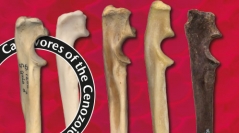

 Geodiversitas
42 (1) - Pages 1-16
Geodiversitas
42 (1) - Pages 1-16In the present paper, we carry out a deep analysis of the functional anatomy of the long bones of the fossil, wolverine-sized mustelid Ischyrictis zibethoides (Blainville, 1841) in comparison with that of several extant related species. The study reveals that this animal lacked specific adaptations for either climbing or running, probably being a terrestrial predator that foraged mostly on the ground. Thus, some features of the anatomy of its long bones suggests that I. zibethoides required a strong control of those articulations involved in terrestrial locomotion, such as the elbow or the coxofemoral joint. Besides this, the gentle caudal inclination of the ulna resembles the morphology exhibited by typical cursorial carnivorans, whereas the absence of lateral torsion in the olecranon suggests flexion-extension movements of the elbow in a parasagittal plane. Other small details, such as the small attachment area for the m. biceps brachii, points towards a general adaptation to terrestrial locomotion. Besides this, another set of features, shared with extant small arboreal mustelids, probably indicates a primitive, retained morphology from arboreal ancestors, rather than climbing abilities, although is very likely that I. zibethoides would be able to climb trees with some skill looking for food or shelter.
Functional anatomy, Carnivora, Mustelidae, Miocene, Europe